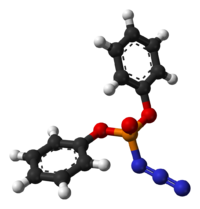- Diphenylphosphoryl azide
-
"DPPA" redirects here. For the Driver's Privacy Protection Act, see Driver's Privacy Protection Act.
Diphenylphosphoryl azide 
 Diphenyl phosphorazidateOther namesDiphenylphosphonic azide
Diphenyl phosphorazidateOther namesDiphenylphosphonic azide
Diphenyl azidophosphate
Phosphoric acid diphenyl ester azideIdentifiers Abbreviations DPPA CAS number 26386-88-9 
PubChem 199401 ChemSpider 172597 
Jmol-3D images Image 1 - O=P(N=[N+]=[N-])(c1ccccc1)c2ccccc2
Properties Molecular formula C12H10N3O3P Molar mass 275.20 g/mol Appearance Colourless or faintly yellow liquid Density 1.277 g/cm3 Boiling point 157 °C (0.2 mmHg)
Hazards EU classification Toxic (C) NFPA 704 Flash point 112 °C  (verify) (what is:
(verify) (what is:  /
/ ?)
?)
Except where noted otherwise, data are given for materials in their standard state (at 25 °C, 100 kPa)Infobox references Diphenylphosphoryl azide (DPPA; IUPAC name: Diphenyl phosphorazidate) is an organic compound. It is widely used in synthesis of other organic compounds.[1]
Synthesis
Diphenylphosphoryl azide has been obtained by reaction of the phosphorochloridate with sodium azide. The stability of the azide towards heating was shown by its distillation at 157 °C and by the fact that vigorous evolution of nitrogen was not observed until a temperature of 175 °C had been reached.[citation needed]
Uses
This compound undergoes pseudohalogen replacement of the azido group by treatment with nucleophilic reagents, such as water, butanol, ammonia, and various amines.
This compound is used as a reagent for the synthesis of peptides by virtue of its reactions with carboxylic acids leading to either the urethane or the amide. The formation of the urethane is particularly valuable since it works with carboxylic acids which fail to undergo the Schmidt reaction, and is believed to involve transfer of the azido group to the carboxylic acid.
It is now suggested that this reaction proceeds through the intermediate mixed anhydride, resulting from attack by the nucleophilic carboxylate anion on the phosphorus atom, with expulsion of the azide ion. The latter then attacks the carbonyl carbon atom, to give the acyl azide and loss of the diphenyl phosphate anion, known to be a good leaving group. Finally, the acyl azide reacts in the normal manner to give the urethane.
The present studies show that diphenylphosphoryl azide reacts with amines giving the corresponding phosphoramidates; it therefore appears that formation of the amide similarly involves the intermediate anhydride, followed by nucleophilic substitution by the amine.
References
- ^ Some Reactions of O,O-Diphenylphosporyl Azide, Australian Journal of Chemistry, 1973, 26, 1591-3.
Categories:- Organophosphoropseudohalidates
- Azides
- Reagents for organic chemistry
- Phenol ethers
Wikimedia Foundation. 2010.


